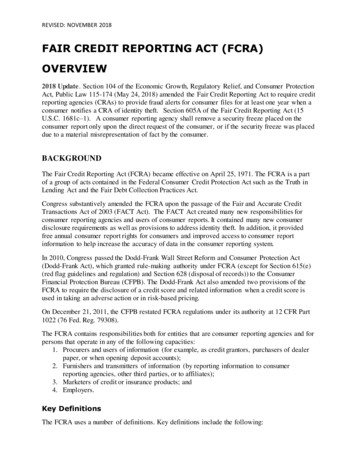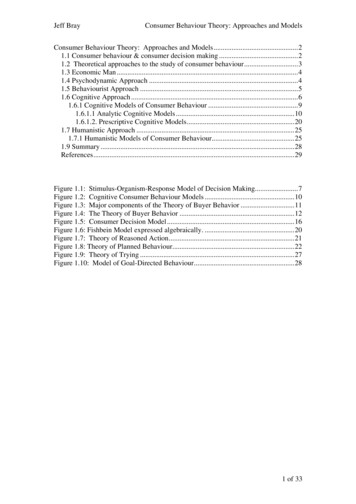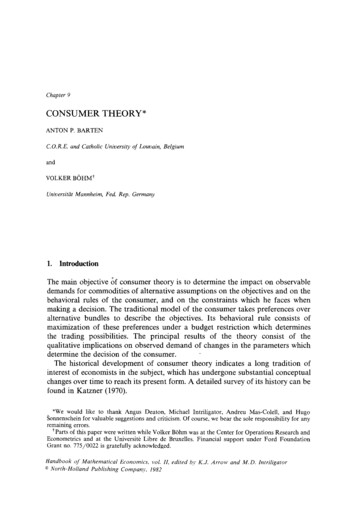
Transcription
A Consumer’s Guide to the California Solar InitiativeStatewide Incentives for Solar Energy Systems
“It’s a great feeling knowing that you are generating electricity without usingany outside fuel source.”—Jack Good, Good & Roberts, Inc., California Solar Initiative Customer“Installation of my solar power system is an investment in the future. Whenis the last time your power bill went down? The answer is that powerbills don’t decrease, so this is a hedge against future cost increases ofelectricity, while at the same time doing the right thing.”—Robert M. Bushman, Homeowner, Thousand Oaks
Table of ContentsThe California Solar Initiative:Saving the Planet One System at a Time .3How Solar Works.4How Net Energy Metering Works.5How Much Solar Systems Cost.6California Solar Initiative Statewide Eligibility .7California Solar Initiative Application Process .7Getting Started with Solar .8Getting Paid: A Quick Guide to California Solar Initiative Incentives .11Clean Power Estimator .11More Facts You Should Know about Going Solar .12Frequently Asked Questions (FAQs) .13Glossary of Commonly Used Terms .17How to Contact the Program Administrators .25"FedEx and its subsidiaries recognize that effective environmentalmanagement is one of its most important corporate priorities. As a globaltransportation industry leader, FedEx believes strongly in progressiveenvironmental stewardship and resource sustainability. These (solar)power generation systems represent another step that FedEx companiesare taking as we work collaboratively toward these objectives."—Mitch Jackson, Director of Environmental Affairs and Sustainability for FedEx Corporation1
“In 2006, I signed the law to create the California Solar Initiative, aworld-class solar program that is transforming the energy economyand creating a sustainable solar industry with a goal of 3,000megawatts of clean and renewable solar power, thereby reducingoutput of greenhouse gas emissions by 3 million tons.Solar energy is a huge step toward meeting our long-term renewableenergy and climate change goals, and further proof that being good tothe environment is also good for the bottom line. Join the thousands ofCalifornia homeowners and businesses choosing to go solar today.”—Governor Arnold Schwarzenegger2
The California Solar Initiative:Saving the Planet One System at a TimeSunlight powers life on our planet. When photovoltaic materials (photomeaning light, voltaic meaning voltage) were first discovered in the late1880s, visionaries like Thomas Edison knew that this sustainablediscovery would one day change the way we power our world.The California Solar Initiative is bringing this change to life, and helpingto make the clean, reliable and inexhaustible energy of the sun even moreaccessible in a state that has long been a national leader inenvironmental stewardship.Today, it is common to power our homes and businesses with solartechnologies. In fact, thousands of your friends, neighbors and businessesalready rely on the state’s most abundant natural resource—the sun—for theirpower, while taking advantage of the financial benefits of Going Solar.The State of California and its electric utilities foster adoption of solarpower by rewarding customers who Go Solar with cash incentives, astreamlined interconnection process and simplified requirements for NetEnergy Metering, which allows for measuring the amount of a customer’senergy production and consumption.Solar energy is so important to our state and our energy future that theCalifornia Solar Initiative provides incentives to residents and businessesfor installing solar electric systems.Solar energy is a renewable alternative to building power plants that burnfossil fuels and emit greenhouse gases, which lead to global warming andclimate change.By Going Solar, you are reinforcing California’s commitment to a healthyenvironment and economy that makes the future bright for California andleaves a legacy of clean energy for generations to come.Purchasing a solar electric system is an investment in your home orbusiness and, as with any investment, careful planning will help you makethe right decisions for your home or business.This booklet introduces customers to the California Solar Initiative and tothe process of installing a solar electric system. It is neither a technicalnor economic guide to designing or installing a system; for that, youshould consult an experienced solar contractor.“The California Solar Initiative incentive from PG&E helps alleviate theup-front costs of installing solar. This makes it a more viable option forthose of us who want to go green.”—Steve Blank, Homeowner, Pescadero3
How Solar WorksThere are two major forms of solar energy: photovoltaic (PV) systems andsolar thermal systems.PV cells convert sunlight into electricity, powering everything from lampsto electronic devices and even electric cars. They work any time the sun isshining, and more electricity is produced when the sunlight is moreintense and strikes the PV modules directly. Solar thermal systems use thesun’s heat to make electricity or are used in water heating applications todisplace gas use. Solar thermal can also be used in large-scale electricgeneration.In PV systems, a flow of direct current (DC) electricity is produced whensunlight strikes an array of solar panels. Appliances and machinery,however, operate on alternating current (AC), as supplied by your utility.The DC energy produced by the panels is fed into an inverter that convertsthe DC power into AC power, which then feeds into the main electricalpanel that powers your home or business.1321. Individual photovoltaic (PV) cellsare connected to panels. Solarpanels convert sunlight into directcurrent (DC) electricity.2. Inverter converts direct current (DC) into alternating current (AC)for electricity in the home.3. The utility meter records the net amount of energy generated through the PV system. When you’recreating more electricity than you’re using, your meter will spin backward and the excess electricity issent to the electric grid. This helps to offset the cost of your electricity usage at night or on cloudy dayswhen your system is not producing electricity.Did You Know? California is #1 in cumulative installed PV capacity per person inthe U.S. with 9.1 Watts per person.4
How Net Energy Metering WorksAt any time of the day, your solar energy system will produce more or lesselectricity than your home or business needs. To allow for Net EnergyMetering, a bi-directional meter measures the electricity flowing into andout of your home or business.For example, when your solar generating system produces more electricitythan your home or business uses, the “excess” electricity automaticallypasses through the meter and onto the utility grid. When this occurs, themeter runs backward and Net Energy Metering generates a bill credit forthe full retail value of the electricity your system is producing at that time.At times when your electricity demand is higher than your solar systemproduces, your home or business uses electricity supplied by your utility.Over a 12-month period, customers on Net Energy Metering will pay for thenet amount of electricity used from their utility over and above the amountof electricity their solar system generates (in addition to monthly nongeneration charges incurred).A Decade of Solar LegislationThe California Solar Initiative Program continues a 10 year tradition ofCalifornia’s support for solar. The California Solar Initiative Program wasestablished by Senate Bill 1 (SB 1) and in a series of decisions from theCalifornia Public Utilities Commission (CPUC) in collaboration with theCalifornia Energy Commission (CEC).The California Solar Initiative Program replaces the solar portion oftwo incentive programs (the Emerging Renewables and Self-GenerationIncentive programs), which started funding solar in California in thelate 1990s.In addition, the CEC administers the 10-year, 400 million New SolarHomes Partnership (NSHP), a separate but coordinated program that offersfinancial incentives for solar PV systems installed on new homes.5
How Much Solar Systems CostNo single answer applies in every case, but incentives offered through theCalifornia Solar Initiative will reduce your expenses in many cases by 20%of the system cost—plus, you could dramatically reduce your annualelectric bills, saving you out-of-pocket immediately.The cost of a PV system depends on a number of factors, including systemsize, equipment options and labor costs. The size of your system may bethe most significant factor in any measurement of cost vs. benefits, theanalysis of which may be done by your solar contractor.It is also important to factor in the cost of capital used to finance yourproject. In simplest terms, prices are discussed in terms of dollars perWatt. Currently, solar industry market reports suggest roughly 9/Watt– 10/Watt for residential systems, and often times less for commercialsystems. As more systems are installed, prices are expected to go down.Incentives are in the range of 1.50/Watt– 2.50/Watt, depending on yourregion, building type and system design. The average residential system is4,000 Watts or 4 kilowatts (kW).6
California Solar Initiative Statewide EligibilityNearly all residential, commercial, government and non-profit customersof the state’s three investor-owned electric utilities—Southern CaliforniaEdison (SCE), Pacific Gas & Electric (PG&E) and San Diego Gas & Electric(SDG&E)—are eligible for incentives provided through the California SolarInitiative for solar systems from one kilowatt (kW) to one megawatt (MW).Most household and small business systems are less than 10 kW;however, for those customers installing systems larger than one MW, thefirst megawatt is eligible for incentives.Responsibility for administration of the program is shared by SCE andPG&E for their respective customers, and by the California Center forSustainable Energy (CCSE), which serves as a third-party administrator forSDG&E customers.Customers of municipal utilities may also qualify for similar incentivesthrough their municipal service provider.Did You Know? Californians have installed 69% of all of the grid-tied PV capacity inthe U.S., which is 280 MW cumulative to date through 2007.Californians have installed about 33,000 out of the nation’s 48,000 solarsystems. The state with the second-most is New Jersey, with 9% oftotal installed capacity.California Solar Initiative Application ProcessThe California Solar Initiative application process is simple. It begins bycompleting a quick, free energy efficiency audit. After doing so, select asolar contractor, who will then help you determine the correct system sizefor your premises. They also will fill out the incentive Reservation RequestForm ( RRF ) and submit it to one of the Program Administrators—SCE,PG&E or CCSE (for SDG&E customers). The Program Administrator willthen reserve the incentive amount based on the size of your solar project.Once your system is installed, you or your solar contractor will contact theutility for permission to connect your system to its electric grid. After yoursystem is inspected and approved, you or your solar contractor will fill outthe Incentive Claim Form (ICF) package and submit it to the ProgramAdministrator for payment. Then you or your solar contractor will receive acheck from the Program Administrator for your incentive amount.Don’t forget to apply for the appropriate federal tax credit if applicable.7
Getting Started with Solar1. Energy Efficiency Self-Audit: Right-Size Your SystemMaking your home or business energy efficient before you Go Solar is anessential first step. Energy-saving actions—such as changingincandescent bulbs to compact fluorescent lamps (CFLs), and replacingold, inefficient appliances—are the best way to save energy and moneywhile providing lasting benefits to the environment.Energy efficiency measures also help reduce the size of the solar systemyou will need, saving you thousands of dollars in up-front installation costs.You will need to complete a simple energy efficiency survey or audit ofyour home or business prior to applying for California Solar Initiativeincentives. If you will be working with a solar contractor, they may be ableto assist with your energy audit and energy efficiency goals.Your California Solar Initiative Program Administrator can provide youwith an easy online audit form: CCSE (for SDG&E customers): www.gosolar.energycenter.org PG&E: www.pge.com/csi SCE: www.sce.com/csi8
2. Select the Right Solar ContractorQualified solar contractors are your key to getting the most productive solarenergy system for your home or business. Typically, the solar contractor willapply for the California Solar Initiative incentives on your behalf andarrange for your system to be interconnected to your utility company'spower grid. The solar contractor may also apply for local permits.The California Solar Initiative Program provides a list of eligible solar contractoravailable online at Searching for an eligible solar contractor by zip code is the fastest way tofind a solar contractor closest to you, although any eligible solarcontractor may work on your project. Solar contractors typically providefree site evaluations, comprehensive quotes and payback information.A qualified solar contractor should be able to evaluate factors that willaffect your PV system performance, such as the roof size, orientation (tiltand direction) of the system, shading and other factors.Just as if you were doing any other type of home improvement, you willwant to contact at least three solar contractors to help ensure you receivethe most competitive bid for your project. It is customary for a solarcontractor to visit your home to help you plan the location and size of yoursystem, as well as choose the incentive type best for you.Online solar contractor lists and guides:www.gosolarcalifornia.ca.gov/retailers (Sponsored by CaliforniaEnergy Commission)www.cslb.ca.gov (Contractors State License Board)3. Apply for IncentivesYour solar contractor will submit a Reservation Request Form (RRF) to yourCalifornia Solar Initiative Program Administrator.After the Program Administrator receives your RRF, they will reserve fundsbased on the size of your solar project. These funds will be reserved for aspecified period of time during which you must install your PV system.Please remember that there is a deadline by which time you mustinterconnect your system and submit your Incentive Claim Form (ICF).Reserving your incentive early ensures your access to the highest applicableincentive. As more solar systems are purchased and installed by Californiaconsumers, the amount of available incentive dollars decreases.9
4. Install Your SystemAs part of the installation process, your solar contractor generally handlesany permitting required by the city or county. Once the required permitsare acquired, a typical residential installation can be completed in threeto five days.Once the system is installed, the city or county may inspect the system.After your new system passes inspection, the utility must be notified tointerconnect your system to the grid. Once interconnected, the ProgramAdministrator may also inspect your system as part of program qualitycontrol efforts.Now that your system is interconnected, you will begin reaping thebenefits of solar power generation and Net Energy Metering. Each month,electricity you produce in excess of your own consumption will be sent backto the utility grid and credited to your account. These credits are used tooffset some or all of your annual electric consumption from the utility.5. Claim Your IncentiveOnce your system has been purchased, installed and is operational, you oryour solar contractor will submit the Incentive Claim Form (ICF) along with anysupporting documentation, including a verification of project cost and acalculation of the expected system output (if there are any changes fromthe time of your reservation request). The Program Administrator willverify that your system has been properly connected to the utility electricgrid before sending your California Solar Initiative incentive payment.Don’t forget to apply for any applicable federal tax credits.10
Getting Paid: A Quick Guide to California SolarInitiative IncentivesThere are two types of incentives available to customers through theCalifornia Solar Initiative Program: the Expected Performance-BasedBuydown (EPBB) and the Performance-Based Incentive (PBI). Both incentivesreward high-performance systems—the EPBB is a one-time, up-frontpayment based on a system’s expected performance; PBI payments arebased on a system’s actual performance and paid out over five years.Expected Performance-BasedBuydown (EPBB)(Paid in dollars/Watt)Performance-BasedIncentive (PBI)(Paid in cents/kWh) Intended for residential and smallbusiness customers Ideal for large commercial, governmentand non-profit customers Systems less than 50 kW* Mandatory for all systems 50 kW*or greater Systems less than 50 kW* canopt-in to PBI Incentive paid per Watt based on yoursystem’s expected future performance(factors include CEC-AC system rating,location, orientation and shading) Incentive paid based on the actualenergy produced by your solarsystem in kilowatt-hours One-time lump sum up-front payment Sixty payments over five years*As of Jan. 1, 2010, this amount will change to 30 kW.Clean Power EstimatorThe Clean Power Estimator is an online software program, availablethrough Go Solar California, that provides California residential andcommercial electric customers a personalized estimate of the cost andbenefits of investing in a PV solar electric generating system.The calculator takes into consideration customer-specific information toprovide the best estimate of a given system’s cost and benefits. Thisinformation includes the estimated cost of the particular system underconsideration, the customer’s location, the applicable incentive level,electric rate schedule and other customer information.The calculator provides a variety of consumer-specific analyses based onthe variables provided by the consumer. Pleasekeep in mind that the Clean Power Estimatorprovides an estimated incentive ec.htmE S T I MAT OR11
More Facts You Should Know about Going Solar If your roof is more than seven years old, it's probably best topostpone solar installation until you replace your roof. A South or Southwest facing roof is considered to be optimal for asolar installation. If you live in a shaded area, your solar production will be impacted.“As a locally elected official, I believe it is important to lead—and motivateothers—by example. For me, it was an easy decision to go solar. It is part ofmy personal commitment to do what I can to help the environment andreduce demand on California's electric grid. The decision to put solarpanels on my home has been a good one for me, and there’s nothing betterthan seeing all the money I’ve saved on my electric bill!”—Mayor Michael T. Bennett, City of Goleta12
Frequently Asked Questions (FAQs)Q. Why should I Go Solar?A. For many reasons: Solar finance experts suggest that every 1,000 of annual energy savingsfrom a PV system adds 20,000 to the resale value of your home. Solar systems are extremely reliable, able to produce clean energyfrom the sun for up to 25 years. By using solar to power your home or business, you dramaticallyreduce your carbon footprint. Incentives are now at their highest in California, and will declineas more systems are installed. Get the best incentive you can—Go Solar now!Q. How much money will I save on my electric bill?A. The potential savings from a solar system will depend on severalfactors, including your current utility rate structure, the size of the solarsystem you install and the amount of sunshine your system will receive.Your solar contractor should be able to provide you with an estimatebased on those and other factors. You can also refer to the Clean PowerEstimator for projected savings (see page 11).Q. What size solar system do I need?A. Several factors will influence the size of the solar system you need.Determining your present electricity needs is a first step in sizing yoursolar system. You should conduct an energy efficiency survey of your homeor business before you determine the size of the system—by installingenergy efficiency measures, you’ll require less energy and could savethousands of dollars on panels.13
Q. Are PV systems reliable?A. Yes. Stationary PV systems have no moving parts; there is nothingmechanical that can wear out. They operate silently, and require no fuel,filters or other costly parts or maintenance.Solar modules are essentially silicon cells (similar to a computer chip)embedded inside a protective layer, usually a sturdy tempered glass panel.They are made to withstand hot, direct sunlight and harsh weatherconditions; they will continue to work as long as sunlight falls on thesurface. They do need to be cleaned periodically to ensure maximumperformance—dust and dirt can reduce a system’s performance.Solar systems usually have an expected life of up to 25 years. Plus,systems receiving incentives under the California Solar Initiative arerequired to have at least a 10-year equipment warranty.Q. Which solar technologies are covered under the California Solar Initiative?A. Incentives are available for solar photovoltaic (PV) technologies (roof-mounted, ground-mounted and building-integrated PV), non-PV electricdisplacing systems, and non-PV solar electric generating systems. Inaddition, customers of SDG&E may be eligible for incentives under theSolar Water Heating Pilot Program. Contact CCSE, the Pilot ProgramAdministrator, for more information.Q. How much are application fees?A. There is no application fee for residential projects and other projectsup to 10 kW. For projects greater than 10 kW, please refer to theCalifornia Solar Initiative Program Handbook or ask your solar contractorabout standard application fees.Q. How can I check on the status of my application?A. Your solar contractor can provide you with regular updates regardingthe status of your application. You can also review details of yourapplication online at http://csi.powerclerk.com.Q. How long will the application process take?A. The California Solar Initiative Program Administrators target less than30 days to confirm both residential and non-residential reservationrequests. To help ensure your application is processed quickly, please takea minute to review your documents and avoid the most frequent issuesencountered with applications: listed equipment does not match theExpected Performance-Based Buydown printout; missing signature(s); andincomplete or missing documentation."It has been nine months since we installed our solar PV system. Itdrastically reduces our energy costs, saving us hundreds of dollars eachmonth. The best part is, we do nothing! It doesn't matter where we are orwhat we do, power generates whenever the sun is up!"—James Jen, El Dorado Hills14
Q. Are there classes offered in solar PV systems?A. Yes. Monthly solar contractor classes are held throughout the state,hosted by the California Solar Initiative Program Administrators.Introductory information sessions for homeowners are also offered insome locations. Please check the Web site of the appropriate ProgramAdministrator for that information. Also, the California Solar Initiativemonthly newsletter provides information on solar-related classes andevents; subscribe at www.gosolarcalifornia.ca.gov/csi.Q. Must I go on a time-of-use (TOU) rate as a condition of California SolarInitiative? Will this cost me more?A. California Solar Initiative applicants are not currently required to takeservice on TOU rates unless otherwise required by other terms of theirservice. However, many customers benefit from TOU rates because solarproduction in the middle of the day generates electricity during peakperiods, and customers receive a Net Energy Metering bill credit at thehigher peak price. Customers should work with their solar contractor andutility to determine what rate is optimal for their unique situation afterthe installation of solar.Q. When I get my California Solar Initiative-funded solar system installed,will I be “off-grid”?A. No. The California Solar Initiative Program only provides incentives forgrid-tied solar systems. When a system produces more power than thecustomer is using, the excess flows into the grid; at night or wheneversite load is greater than the system’s generation, the customer drawspower from the grid. Thus, consumers who install solar systems under theCalifornia Solar Initiative Program remain connected to the utility grid.15
Did You Know? Californians installed 81 MW in 2007, which was 58% of all gridtied PV capacity in the U.S., making California the number onestate in the country, with an increase of 38% over 2006. Thenext largest state was New Jersey with 11% of the market.Q. Do I need a battery backup for my solar electric generating system?A. A battery backup for your solar system is unnecessary when yoursystem is connected to your utility’s electric grid. The grid serves as abackup during times when your system is not producing electricity, forexample, at night and on very cloudy days.Q. What happens during a power outage?A. Your solar electric system is designed to shutdown immediately forsafety reasons, unless it includes a battery storage system.Q. Can my city, homeowners’ association or neighbor prohibit me frominstalling solar on my roof?A. No. The California Solar Rights Act, enacted in 1978, limits the abilityof codes, covenants and restrictions to restrict solar installations.Q. Is the power produced by the solar system any different from the utilitypower? Will it hurt my home appliances or business equipment?A. No. The electricity generated by your solar system is no different fromelectricity delivered by your local utility. The solar system connectsdirectly to your utility panel or circuit breaker box, so it interfacesseamlessly with your utility power.Q. Does a solar PV system have to meet local building codes?A. Yes. You will probably need to obtain a permit from the city or countybuilding department, and may be required to purchase a building permitand/or electrical permit to legally begin installation. A solar contractorshould be able to assist you with local permitting issues.Q. Can I install a solar PV system myself?A. While uncommon, self-installations are allowed so long as properbuilding permits are obtained and local codes are followed.Q. Where can I get more information?A. For additional information on Going Solar in California, visitwww.gosolarcalifornia.ca.gov, or the Web sites of the respective ProgramAdministrators (see page 25).Want more info?The California Solar Initiative electronic newsletter provides monthlyprogram updates and news for California Solar Initiative participants.Please visit www.gosolarcalifornia.ca.gov/news to subscribe.16
Glossary of Commonly Used Terms(Refer to the California Solar Initiative Program Handbook for more details.)Alternating Current (AC):Alternating current (AC) is an electric current whose direction reversescyclically, as opposed to direct current (DC), whose direction remainsconstant. AC is the form of electricity that is delivered to your home orbusiness. Solar photovoltaic (PV) systems produce DC power, which mustbe converted to AC by an inverter. Under the California Solar InitiativeProgram, PV electric output is converted to a value called CEC-AC Rating.(See CEC-AC Rating).Applicant:The entity (the Host Customer, System Owner or a third-party designatedby the Host Customer) responsible for filling out and submitting theCalifornia Solar Initiative application and all related materials. Theapplicant serves as the main point of contact with the California SolarInitiative Program Administrator.Array:Any number of electrically connected photovoltaic (PV) panels providing asingle electrical output.Azimuth:Azimuth is the horizontal angular distance between the vertical planecontaining a point in the sky and true south. All references to azimuthwithin the California Solar Initiative Program, unless expressly statedotherwise, refer to true, not magnetic, azimuth.Building Integrated Photovoltaic (BIPV):BIPV technologies form part of the structure to which they are affixed.Typically integrated into the roofing system, BIPV products can providearchitectural interest and/or a very unobtrusive installation.Capacity Factor:The capacity factor for an electricity generating unit is the ratio of theenergy produced during a given time period, measured in kilowatt-hours(kWh), to the energy the unit could have produced if it had been operatingat its rated capacity during that period, expressed in kilowatts (kW):Capacity factor kWh of electricity generatedRated generating capacity (kW) x period (in hours)Did
nor economic guide to designing or installing a system; for that, you should consult an experienced solar contractor. "The California Solar Initiative incentive from PG&E helps alleviate the up-front costs of installing solar. This makes it a more viable option for those of us who want to go green." —Steve Blank, Homeowner, Pescadero











